This document provides an introduction to Fermat's Last Theorem. It discusses how proving the theorem for specific cases of n=4 and prime numbers is sufficient to prove it generally. It also covers some of the early work done to attempt to prove the theorem, including using Pythagorean triples to represent solutions and the method of infinite descent. The document then gives proofs for n=4 using these techniques, showing there are no integer solutions to the equation.
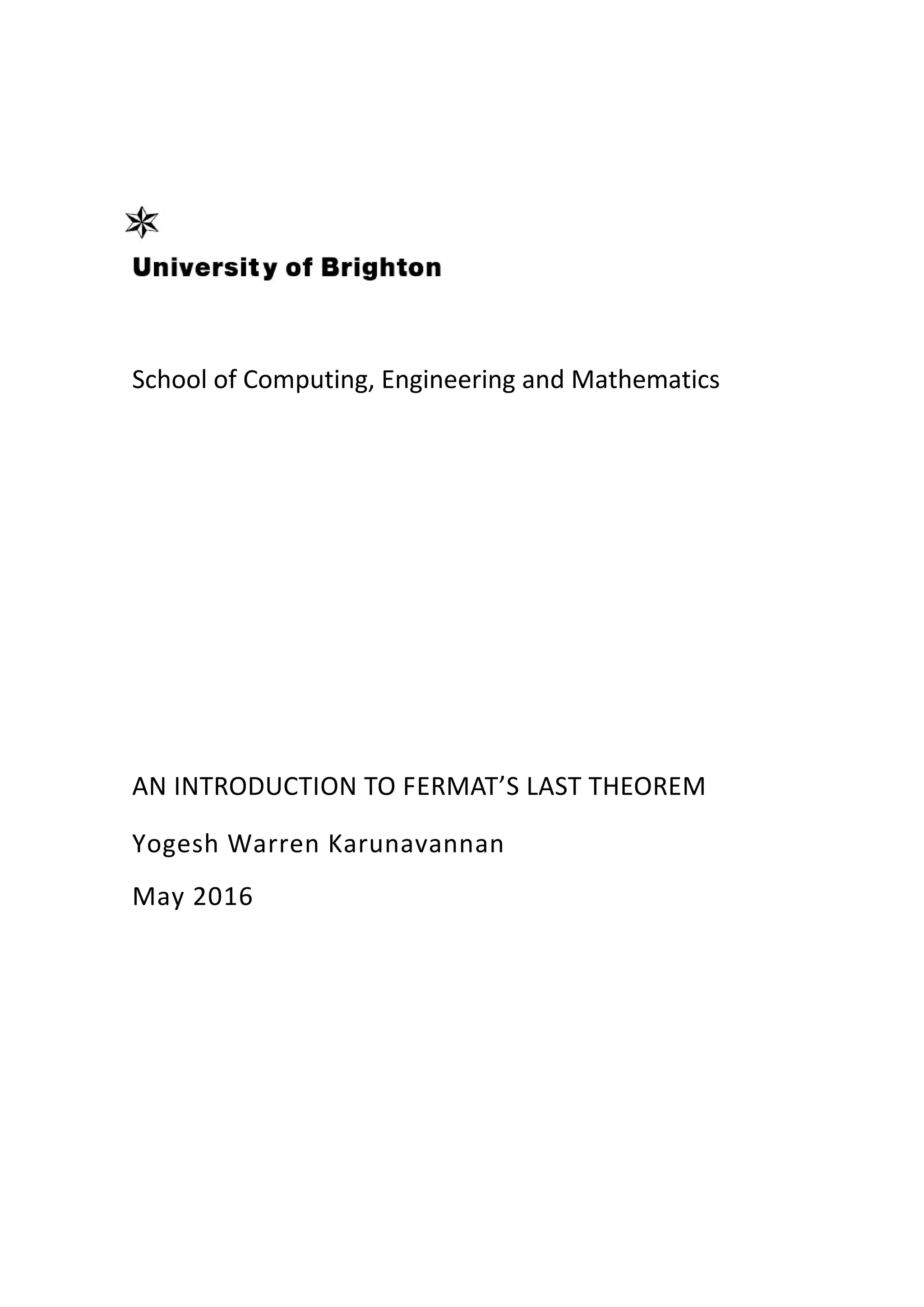


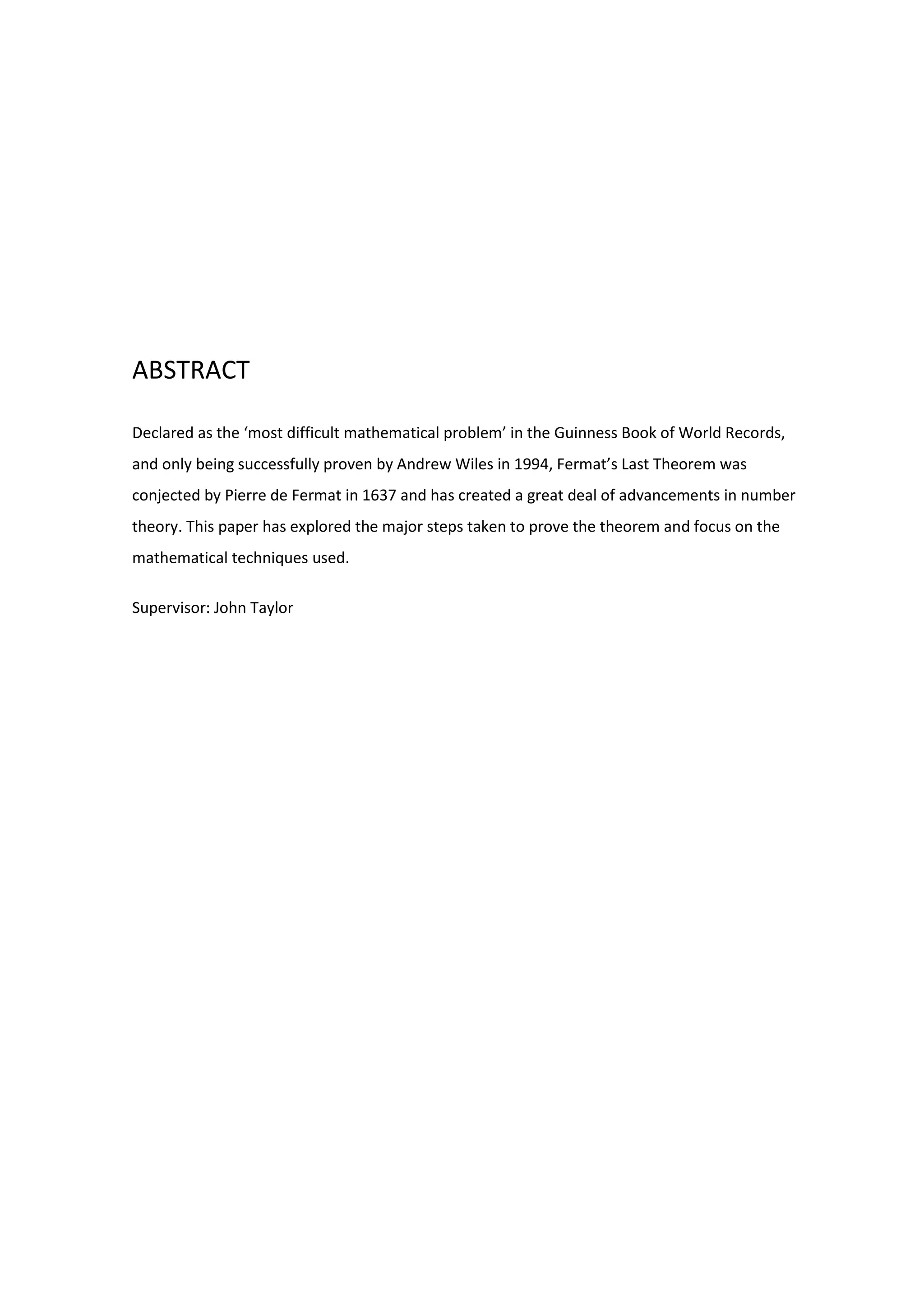

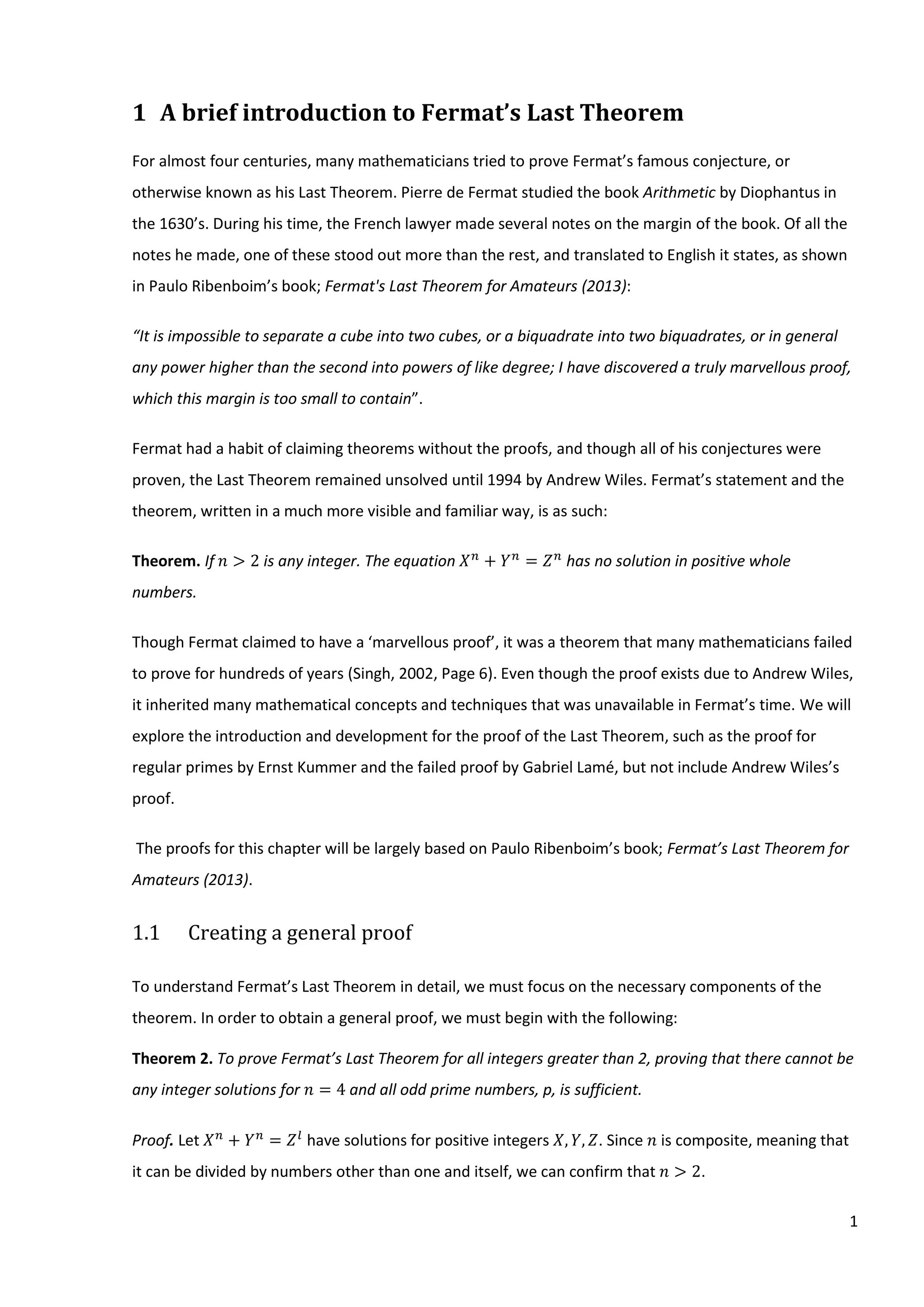


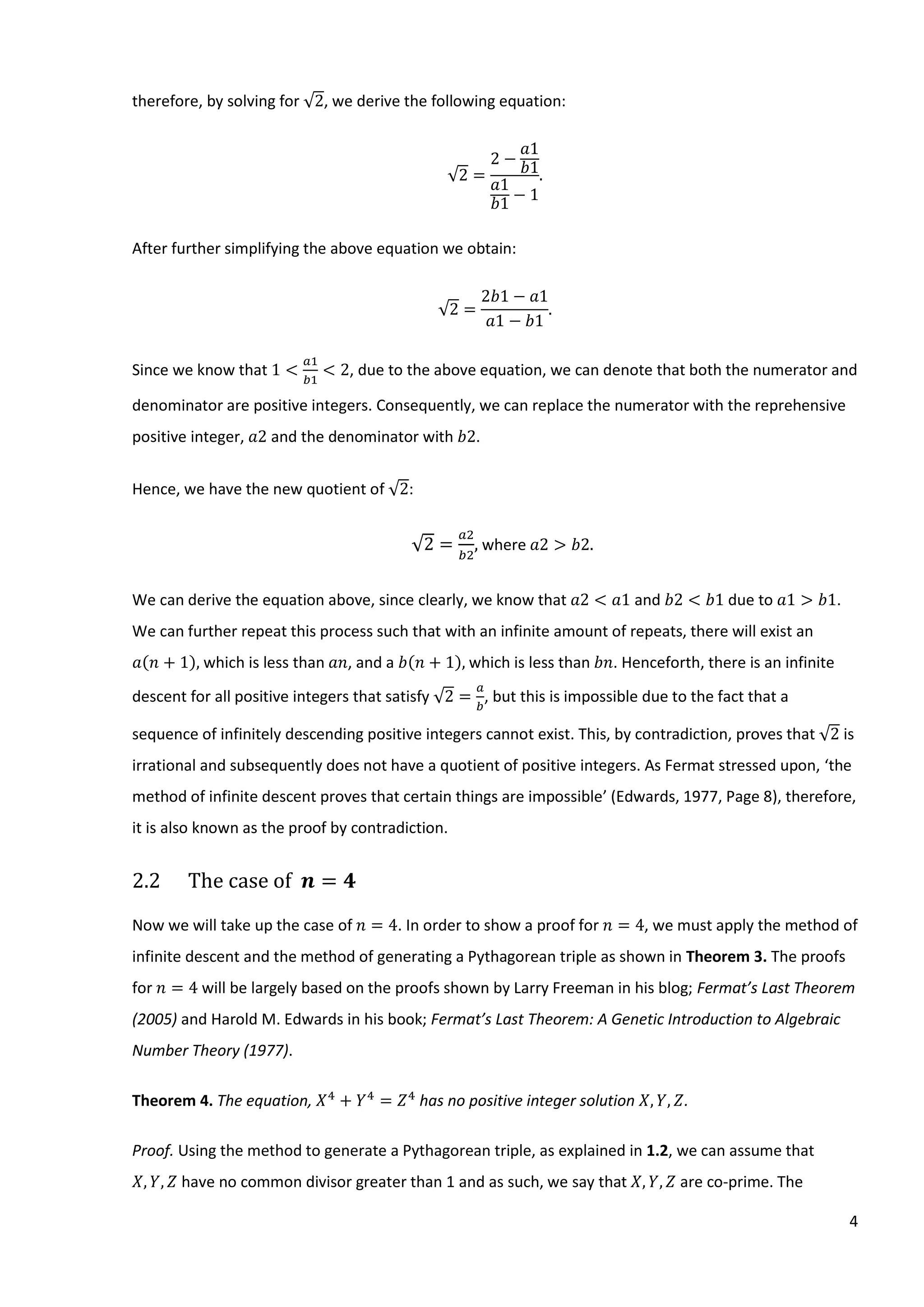
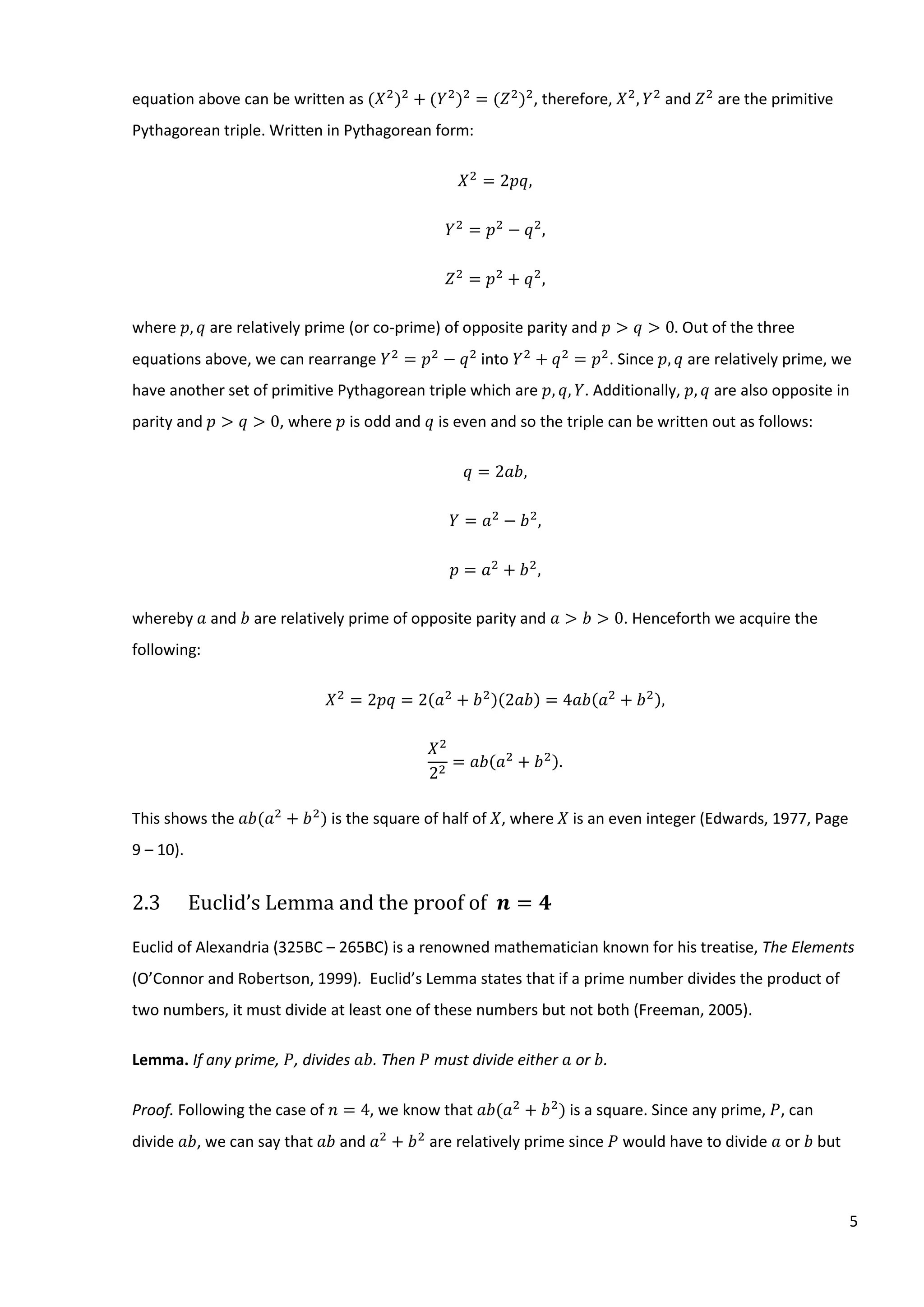
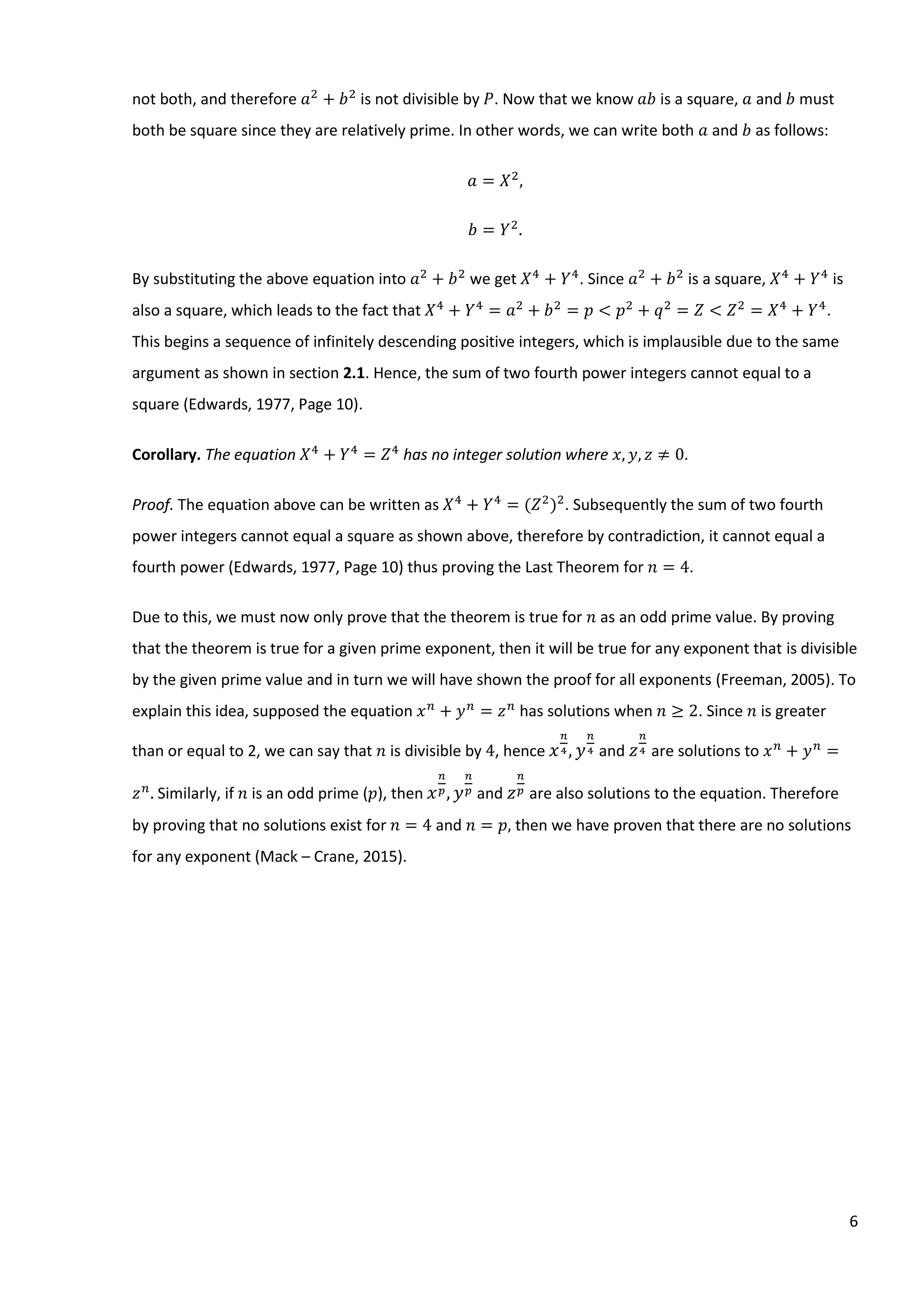
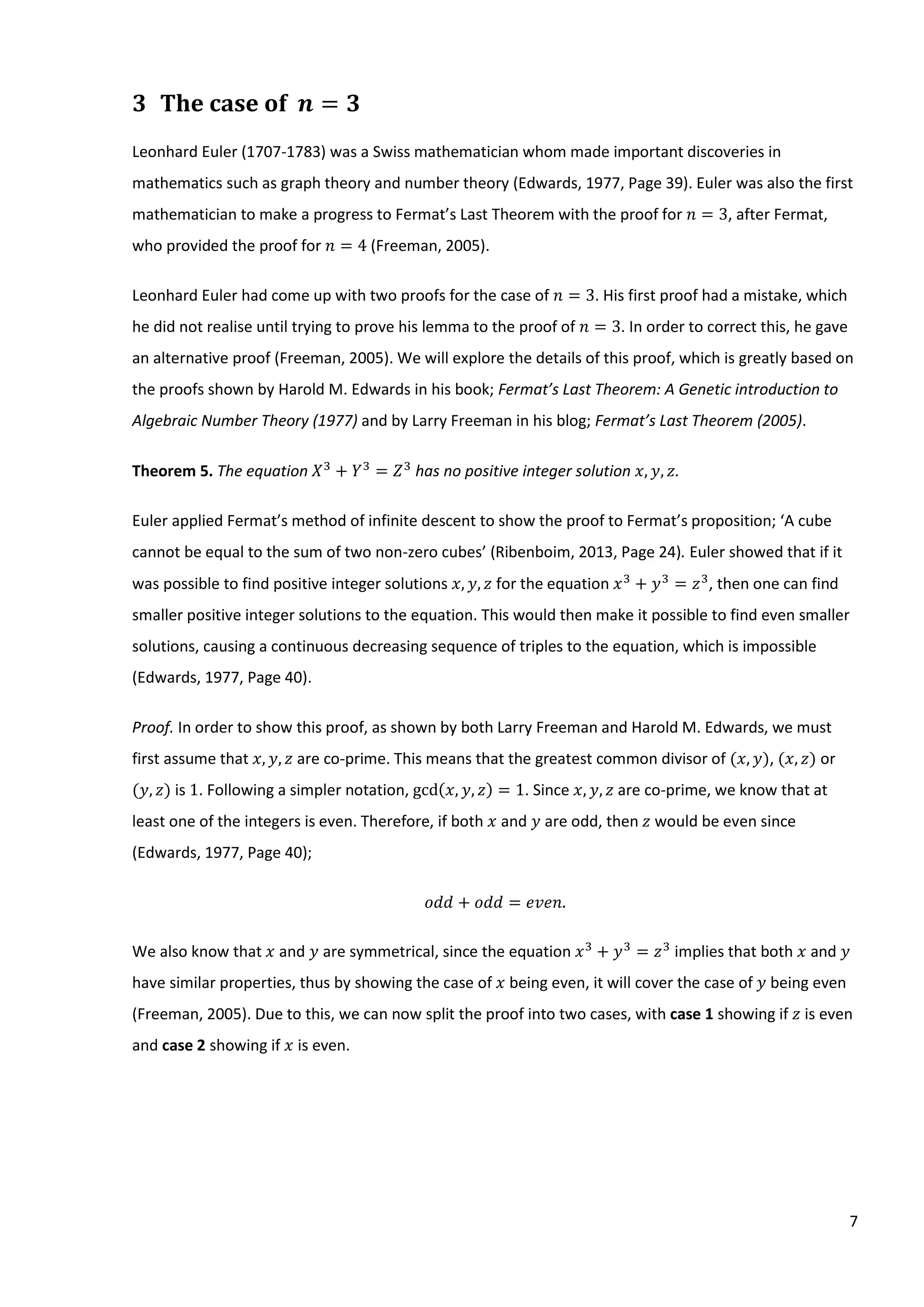
![8
Case 1: 𝒛 is even
Lemma 2. If 𝑧 is even, then 𝑝, 𝑞 exists such that:
1. gcd(𝑝, 𝑞) = 1.
2. 𝑝, 𝑞 are positive.
3. Either 𝑝 or 𝑞 is odd, therefore, have opposite parity.
4. 𝑥3
+ 𝑦3
= 𝑧3
only has a solution if 𝑝, 𝑞 exists with the above properties.
Proof. Since we have assumed that 𝑥, 𝑦, 𝑧 are co-prime and we have assumed that 𝑧 is even for this case,
then 𝑥 and 𝑦 are odd such that (Edwards, 1977, Page 40 – 41):
𝑥 + 𝑦 = 𝑒𝑣𝑒𝑛,
𝑥 − 𝑦 = 𝑒𝑣𝑒𝑛.
With the above in mind, let:
2𝑝 = 𝑥 + 𝑦,
2𝑞 = 𝑥 − 𝑦.
Since any number 𝑝, 𝑞 would be even if in the form 2𝑝, 2𝑞. We will then have 𝑥 and 𝑦 such that:
𝑥 =
1
2
(2𝑝 + 2𝑞) = 𝑝 + 𝑞,
𝑦 =
1
2
(2𝑝 − 2𝑞) = 𝑝 − 𝑞.
This can be worked out by applying the method of solving simultaneous equations to 2𝑝 = 𝑥 + 𝑦 and
2𝑞 = 𝑥 − 𝑦. We can now express 𝑥3
+ 𝑦3
= 𝑧3
in terms of 𝑝, 𝑞:
𝑧3
= 𝑥3
+ 𝑦3
,
= (𝑥 + 𝑦)(𝑥2
− 𝑥𝑦 + 𝑦2),
= (𝑝 + 𝑞 + 𝑝 − 𝑞)[(𝑝 + 𝑞)2
− (𝑝 + 𝑞)(𝑝 − 𝑞) + (𝑝 − 𝑞)2],
= 2𝑝(𝑝2
+ 3𝑞2
).
Both 𝑝 and 𝑞 have opposite parity since both 𝑝 + 𝑞 = 𝑥 and 𝑝 − 𝑞 = 𝑦 are odd. Equally 𝑝 and 𝑞 also
have gcd(𝑝, 𝑞) = 1 since any factor that divides into 𝑝 and 𝑞 would divide into 𝑥 and 𝑦, but that is](https://image.slidesharecdn.com/85132124-5d34-4c0d-9c38-12262f7c352c-160714205513/75/Fermat-s-Last-Theorem-Final-Copy-13-2048.jpg)
![9
impossible as 𝑥 and 𝑦 are co-prime, hence it would be contradictory if that was the case. With this in
mind, it can be said that there can exist a solution 𝑥, 𝑦 to 𝑥3
+ 𝑦3
= 𝑧3
due to the co-prime integers,
𝑝, 𝑞, existing such that (Freeman, 2005):
𝑧3
= 2𝑝(𝑝2
+ 3𝑞2) = 𝑐𝑢𝑏𝑒.
Case 2: 𝒙 is even
The same argument can be applied to case 2. In order to show the proof, we will be using Lemma 2 as
shown in case 1, but with the difference in being 𝑥 is even rather than 𝑧.
Proof. As we know, 𝑥, 𝑦, 𝑧 are co-prime, therefore, 𝑦 and 𝑧 are both odd. In turn 𝑧 + 𝑦 and 𝑧 − 𝑦 are
both even, therefore there exists 𝑝, 𝑞 such that we let (Freeman, 2005):
2𝑝 = 𝑧 − 𝑦,
2𝑞 = 𝑧 + 𝑦,
due to the fact that the equation will be rearranged to 𝑥3
= 𝑧3
− 𝑦3
since 𝑥 is now even. Using
simultaneous equations, we have 𝑥, 𝑦 such that:
𝑧 = 𝑞 + 𝑝,
𝑦 = 𝑞 − 𝑝.
Since 𝑧, 𝑦 are both odd, 𝑝 and 𝑞 have opposite parity, and using the same argument as case 1,
gcd(𝑝, 𝑞) = 1. Therefore, there exists 𝑝, 𝑞 such that:
𝑥3
= [𝑞 + 𝑝 − (𝑞 − 𝑝)][(𝑞 + 𝑝)2
+ (𝑞 + 𝑝)(𝑞 − 𝑝) + (𝑞 − 𝑝)2]
= 2𝑝(𝑝2
+ 3𝑞2) = 𝑐𝑢𝑏𝑒.
This results in the same conclusion as case 1 (Freeman, 2005).
Now that we have shown that regardless of either 𝑥, 𝑦, 𝑧 being even, it will conclude with coprime
positive integers 𝑝, 𝑞 such that 2𝑝(𝑝2
+ 3𝑞2
) is a cube. The next step is to show that 2𝑝 and 𝑝2
+ 3𝑞2
are co-prime and ‘that the only way that their product can be a cube is for each of them separately to be
a cube’ (Edwards, 1977, Page 41).
We know that 𝑝 and 𝑞 have opposite parity due to Lemma 2, therefore 𝑝2
+ 3𝑞2
is odd, and we know
that 𝑝 and 𝑞 are co-prime, therefore we end up with the argument that if the above statement is true,
then gcd(2𝑝, 𝑝2
+ 3𝑞2) = 1 or 3.](https://image.slidesharecdn.com/85132124-5d34-4c0d-9c38-12262f7c352c-160714205513/75/Fermat-s-Last-Theorem-Final-Copy-14-2048.jpg)

![11
Case 1: 3 does not divide into 𝒑
Since we are taking up that case that gcd(2p, p2
+ 3q2) = 1, we can assume that 2p and p2
+ 3q2
are
cubes due to the Relatively Prime Divisors Lemma, the proof to this can be found in Larry Freeman’s
Blog; Fermat’s Last Theorem (2005). This Lemma states that if gcd(𝑎, 𝑏) = 1 and 𝑎𝑏 = 𝑧 𝑛
, then there
exists 𝑥, 𝑦 such that:
𝑎 = 𝑥 𝑛
𝑏 = 𝑦 𝑛
.
Applying this to our case, we know that 𝑧3
= 2𝑝(𝑝2
+ 3𝑞2
) and gcd(2𝑝, 𝑝2
+ 3𝑞2) = 1, then there
exists 𝑥, 𝑦 such that:
𝑥3
= 2𝑝
𝑦3
= 𝑝2
+ 3𝑞2
.
There forth an assumption that 2𝑝, 𝑝2
+ 3𝑞2
are both cubes can be made.
Lemma 4. If gcd(2𝑝, 𝑝2
+ 3𝑞2) = 1, then there must be smaller solutions to Fermat’s Last Theorem: 𝑛 =
3.
Proof. Since we know that 2𝑝, 𝑝2
+ 3𝑝2
are cube, then we know that there exists 𝑎, 𝑏 such that
gcd(𝑎, 𝑏) = 1 and both 𝑎, 𝑏 have opposite parities since 𝑝, 𝑞 also have opposite parities. Let 𝑢3
= 𝑝2
+
3𝑞2
, since we are applying Relatively Prime Divisors Lemma (Freeman, 2005). We know that 𝑝, 𝑞 have
opposite parities, in regards to which 𝑢 can be stated as odd and so 𝑢 will be in the form of 𝑎2
+ 3𝑏2
because we know gcd(𝑎, 𝑏) = 1, which means that every odd factor in the form 𝑎2
+ 3𝑏2
will have the
same form.
As a result of the above:
𝑢3
= (𝑎2
+ 3𝑏2
)3
,
= 𝑎2
+ 3𝑏2
(𝑎2
+ 3𝑏2
)2
,
= (𝑎2
+ 3𝑏2)(𝑎4
+ 6𝑎2
𝑏2
+ 9𝑏4),
= (𝑎2
+ 3𝑏2)(𝑎4
− 6𝑎2
𝑏2
+ 12𝑎2
𝑏2
+ 9𝑏4),
= (𝑎2
+ 3𝑏2)[(𝑎2
− 3𝑏2
)2
+ 3(2𝑏)2],](https://image.slidesharecdn.com/85132124-5d34-4c0d-9c38-12262f7c352c-160714205513/75/Fermat-s-Last-Theorem-Final-Copy-16-2048.jpg)
![12
= [𝑎(𝑎2
− 3𝑏2) − 3𝑏(2𝑎𝑏)]2
+ 3[𝑎(2𝑎𝑏) + 𝑏(𝑎2
− 3𝑏2)]2
,
= (𝑎3
− 3𝑎𝑏2
− 6𝑎𝑏2
)2
+ 3(2𝑎2
𝑏 + 𝑎2
𝑏 − 3𝑏3
)2
,
= (𝑎3
− 9𝑎𝑏2
)2
+ 3(3𝑎2
𝑏 − 3𝑏3
)2
.
As 𝑢3
= 𝑝2
+ 3𝑞2
, then 𝑝2
+ 3𝑞2
= (𝑎3
− 9𝑎𝑏2
)2
+ 3(3𝑎2
𝑏 − 3𝑏3
)2
. This allows us to define 𝑎, 𝑏
such that :
𝑝 = 𝑎3
− 9𝑎𝑏2
= 𝑎(𝑎 − 3𝑏)(𝑎 + 3𝑏),
𝑞 = 3𝑎2
𝑏 − 3𝑏3
= 3𝑏(𝑎 − 𝑏)(𝑎 + 𝑏),
where gcd(𝑎, 𝑏) = 1.
We can now substitute the value for 𝑝 into 2𝑝, therefore (Freeman, 2005):
2𝑝 = 2(𝑎3
− 9𝑎𝑏2),
= 2𝑎3
− 18𝑎𝑏2
,
= 2𝑎(𝑎 − 3𝑏)(𝑎 + 3𝑏).
Since 𝑎, 𝑏 are opposite parities, we know that both 𝑎 − 3𝑏 and 𝑎 + 3𝑏 are odd. Due to this, any
common factor that divides into 2𝑎, 𝑎 ± 3𝑏 would also be a common factor of 𝑎, 𝑎 ± 3𝑏 and
subsequently, be a common factor to 𝑎, ±3𝑏 (Edwards, 1977, Page 42). We know that this common
factor cannot be 2 since 2 cannot divide into 𝑎 ± 3𝑏, therefore the only common factor would be 3. But
if 3 divides into 𝑎, it would then be able to divide into 𝑝 which is impossible since gcd(2𝑝, 𝑝2
+ 3𝑞2) =
1.
As a result of this, 2𝑎, 𝑎 ± 3𝑏 are co-prime and all three are cube due to the Relative Prime Divisors
Lemma. We now have 𝐴, 𝐵, 𝐶 such that (Edwards, 1977, Page 42):
𝐴3
= 2𝑎
𝐵3
= 𝑎 − 3𝑏
𝐶3
= 𝑎 + 3𝑏.
From the above equations, we can see that 𝐵3
+ 𝐶3
= 2𝑎 = 𝐴3
, this gives a solution smaller than 𝑥, 𝑦, 𝑧
where 𝑥3
+ 𝑦3
= 𝑧3
. We know this is the case since (𝐴3)(𝐵3)(𝐶3) = 2𝑎(𝑎 − 3𝑏)(𝑎 + 3𝑏) = 2𝑝,
where 𝑥3
or 𝑧3
is 2𝑝(𝑝2
+ 3𝑞2
) as shown in case 1: 𝒛 is even and case 2: 𝒙 is even.](https://image.slidesharecdn.com/85132124-5d34-4c0d-9c38-12262f7c352c-160714205513/75/Fermat-s-Last-Theorem-Final-Copy-17-2048.jpg)
![13
Case 2: 3 divides into 𝒑
Now, our final case to show that 𝑥3
+ 𝑦3
= 𝑧3
has no integer solution 𝑥, 𝑦, 𝑧 only differs slightly from
the previous case. In both cases, we have the same assumptions, therefore, 𝑝, 𝑞 are co-prime with
opposite parity and 2𝑝, 𝑝2
+ 3𝑞2
are a cube. The difference, in this case, would be the fact that
gcd(2𝑝, 𝑝2
+ 3𝑞2) = 3 (Freeman, 2005).
Lemma 5. If gcd(2𝑝, 𝑝2
+ 3𝑞2) = 3, then there must be smaller solutions to Fermat’s Last Theorem:
𝑛 = 3.
Proof. To begin, we note that 3 divides into 𝑝 but does not divide into 𝑞, since 3 can divide into 2𝑝 as
the gcd(2𝑝, 𝑝2
+ 3𝑞2) = 3 (Edwards, 1977, Page 42). But 𝑝 and 𝑞 are co-prime, therefore due to
Euclid’s Lemma, if 3 divides into 𝑝, it cannot divide into 𝑞. Since 3 divides into 𝑝, there exists 𝑓 such that
(Freeman, 2005):
𝑝 = 3𝑓.
By substituting the value of 𝑝 into 2𝑝(𝑝2
+ 3𝑞2) we acquire:
2𝑝(𝑝2
+ 3𝑞2) = [2(3𝑓)((3𝑓)2
+ 3𝑞2)],
= 32(2𝑓)(3𝑓2
+ 𝑞2).
Since 3 cannot divide 𝑞, it cannot divide 3𝑓2
+ 𝑞2
. As a result of this, 32
(2𝑓) and 3𝑓2
+ 𝑞2
are co-
prime. Consequently, 𝑓 and 𝑞 are also of opposite parity, and therefore gcd(𝑓, 𝑞) = 1 since gcd(𝑝, 𝑞) =
1. We know that 2𝑝(𝑝2
+ 3𝑞2
) is cube, thus 32(2𝑓), 3𝑓2
+ 𝑞2
are also cubes, since 2𝑝(𝑝2
+ 3𝑞2) =
32(2𝑓)(3𝑓2
+ 𝑞2
).
From the previous case, we calculated 𝑝2
+ 3𝑞2
= (𝑎3
− 9𝑎𝑏2
)2
+ 3(3𝑎2
𝑏 − 3𝑏3
)2
, therefore, as
before, there exists 𝑎, 𝑏 such that (Freeman, 2005):
𝑞 = 𝑎3
− 9𝑎𝑏2
= 𝑎(𝑎 − 3𝑏)(𝑎 + 3𝑏),
𝑓 = 3𝑎2
𝑏 − 3𝑏3
= 3𝑏(𝑎 − 𝑏)(𝑎 + 𝑏),
where gcd(𝑎, 𝑏) = 1.
Due to the fact that we know 32
(2𝑓) is a cube, we can define 𝑎, 𝑏 further such that:
32(2𝑓) = 32[2(3𝑎2
𝑏 − 3𝑏3)],](https://image.slidesharecdn.com/85132124-5d34-4c0d-9c38-12262f7c352c-160714205513/75/Fermat-s-Last-Theorem-Final-Copy-18-2048.jpg)
![14
= 33[2(𝑎2
𝑏 − 𝑏3)],
= 33[2𝑏(𝑎2
− 𝑏2)],
= 33[2𝑏(𝑎 − 𝑏)(𝑎 + 𝑏)].
Following from the fact that 32
(2𝑓) is a cube, then 33[2𝑏(𝑎 − 𝑏)(𝑎 + 𝑏)] is a cube, and subsequently
2𝑏(𝑎 − 𝑏)(𝑎 + 𝑏) is also a cube. For that reason, there exists 𝐴, 𝐵, 𝐶 such that:
𝐴3
= 2𝑏
𝐵3
= 𝑎 − 𝑏
𝐶3
= 𝑎 + 𝑏.
This, in turn, gives another solution to Fermat’s Last Theorem; 𝑛 = 3 as 𝐵3
+ 𝐶3
= 2𝑏 = 𝐴3
, whereby
𝐴3
𝐵3
𝐶3
is less than 𝑓 = 3𝑎2
𝑏 − 3𝑏3
= 3𝑏(𝑎 − 𝑏)(𝑎 + 𝑏) which is also less than 𝑝 = 3𝑓, which is less
than 𝑥3
or 𝑧3
= 2𝑝(𝑝2
+ 3𝑞2
) as well (Edwards, 1977, Page 42).
Corollary 2. 𝑋 𝟑
+ 𝑌3
= 𝑍3
has no integer solution 𝑥, 𝑦, 𝑧.
Proof. In both cases where gcd(2𝑝, 𝑝2
+ 3𝑞2) = 1 or 3, we acquire smaller and smaller solutions to the
already existing small solutions, which is impossible. Therefore, this proves that there are no integer
solutions to the equation by the method of infinite descent.](https://image.slidesharecdn.com/85132124-5d34-4c0d-9c38-12262f7c352c-160714205513/75/Fermat-s-Last-Theorem-Final-Copy-19-2048.jpg)
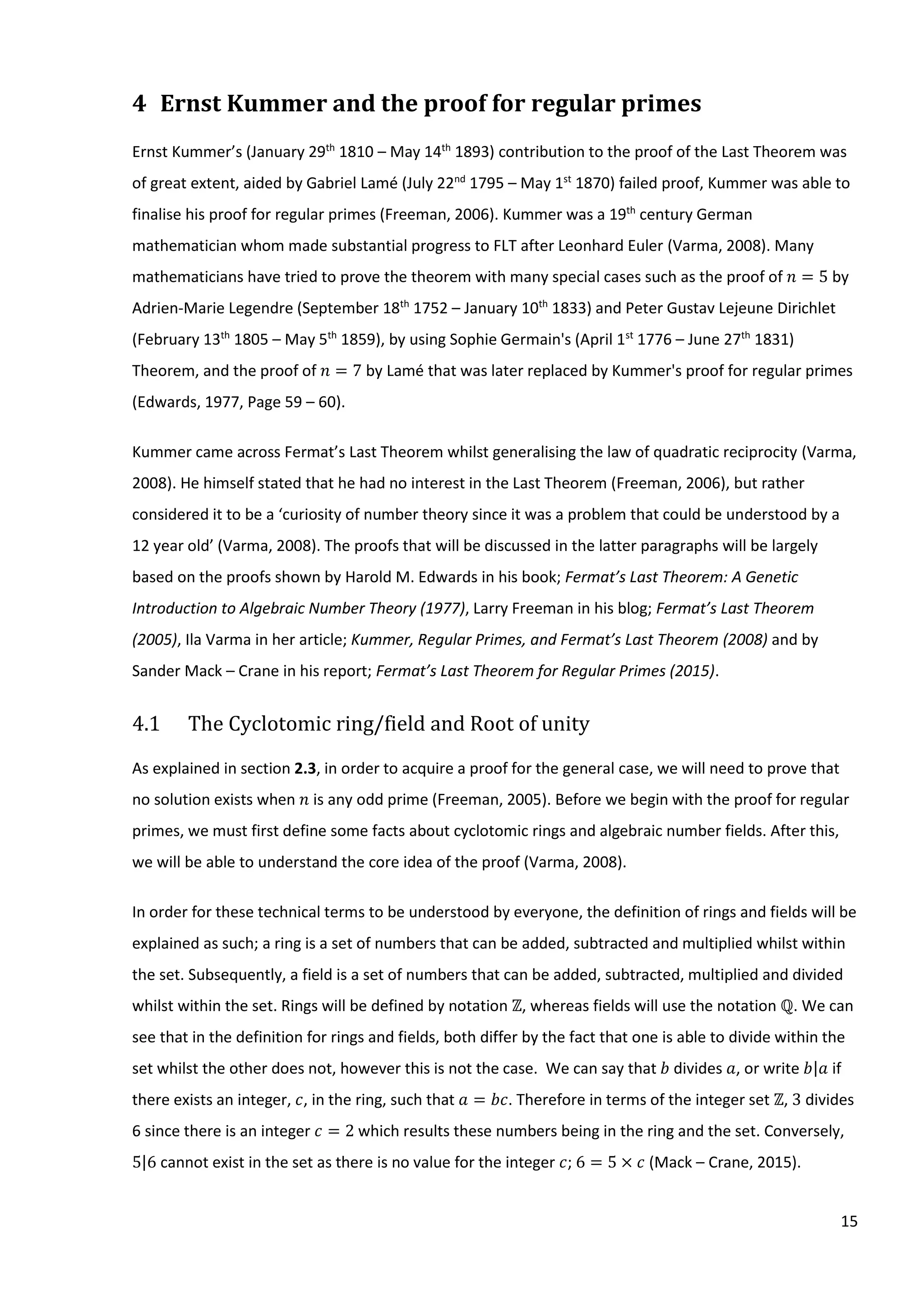
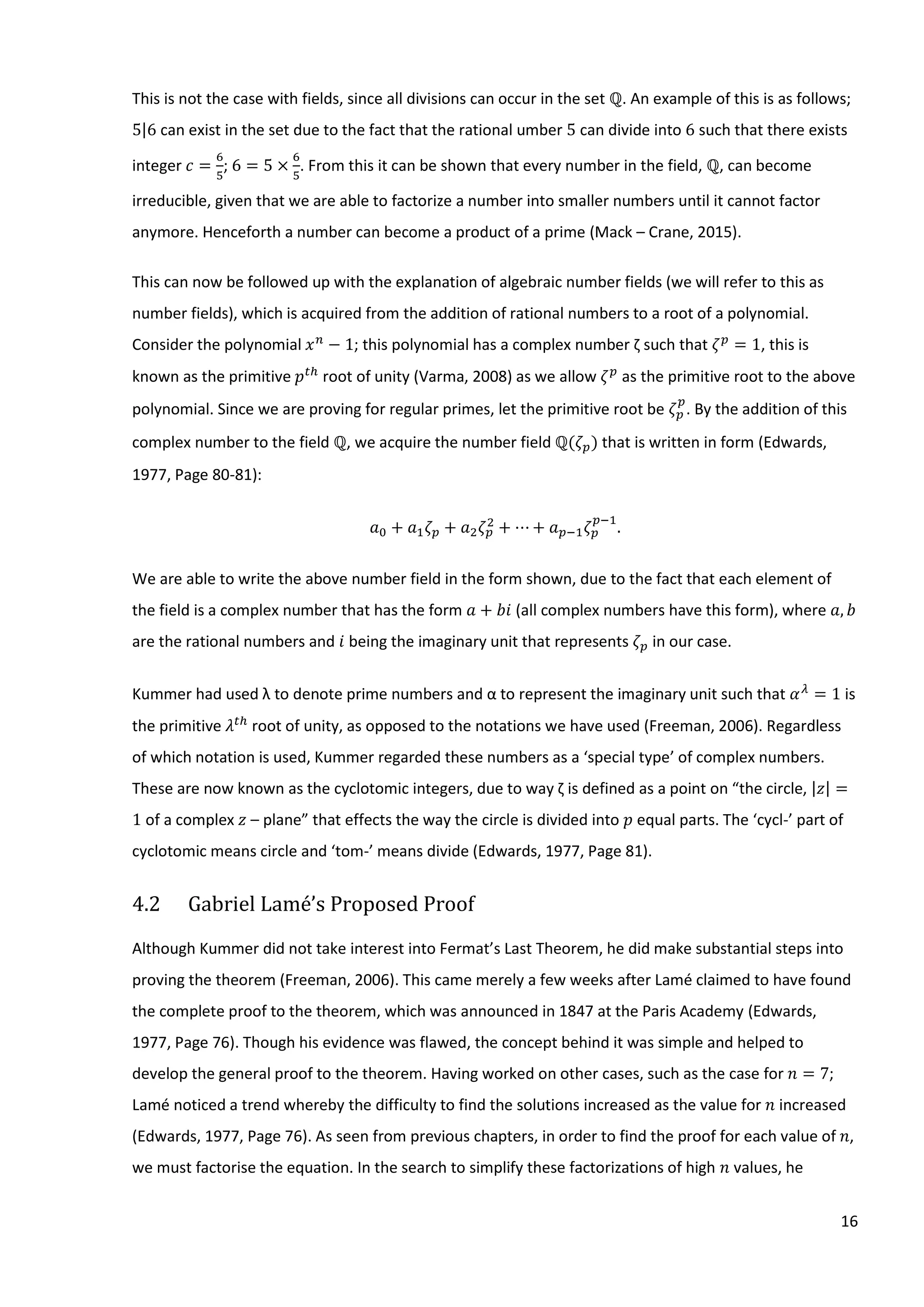

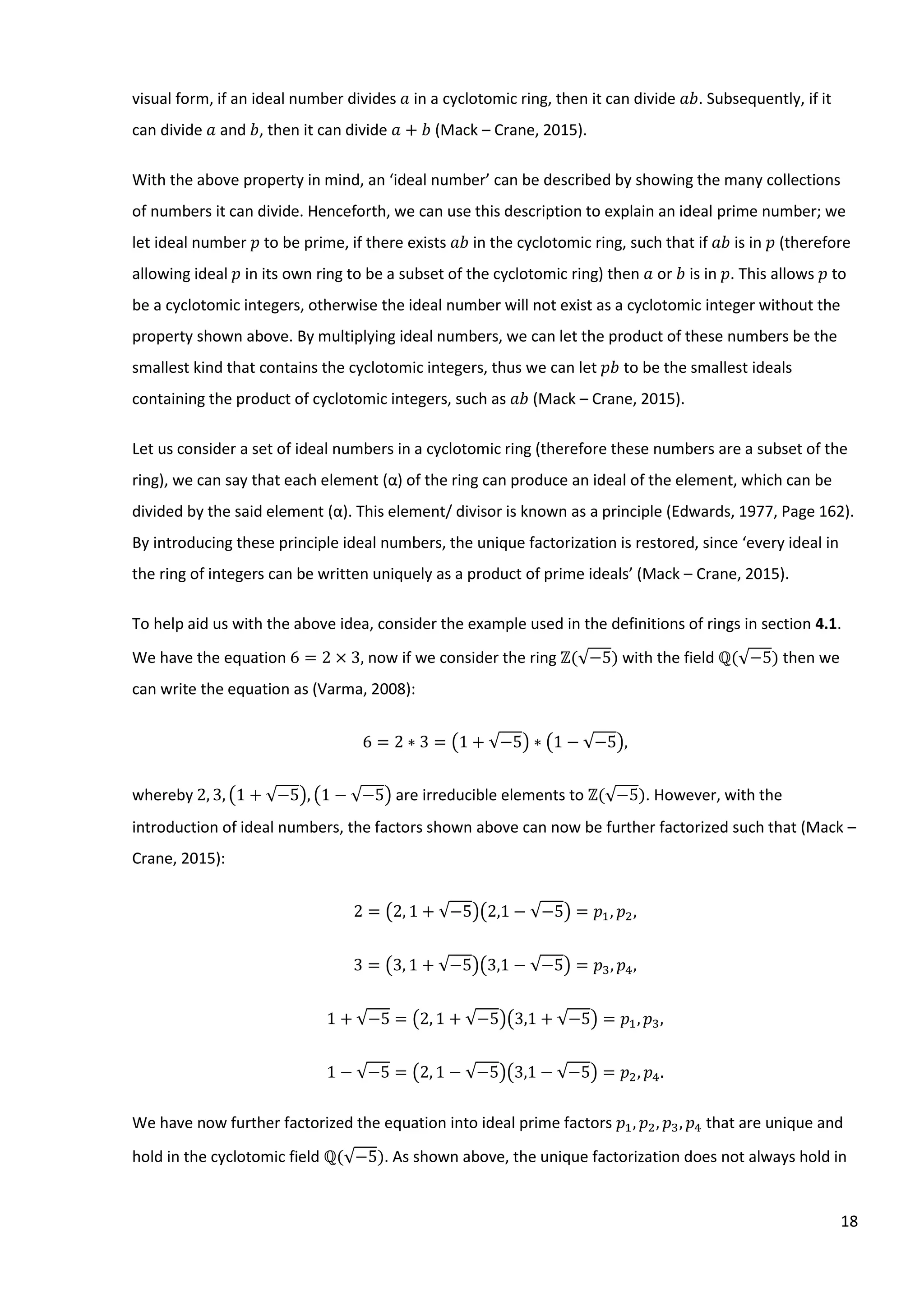
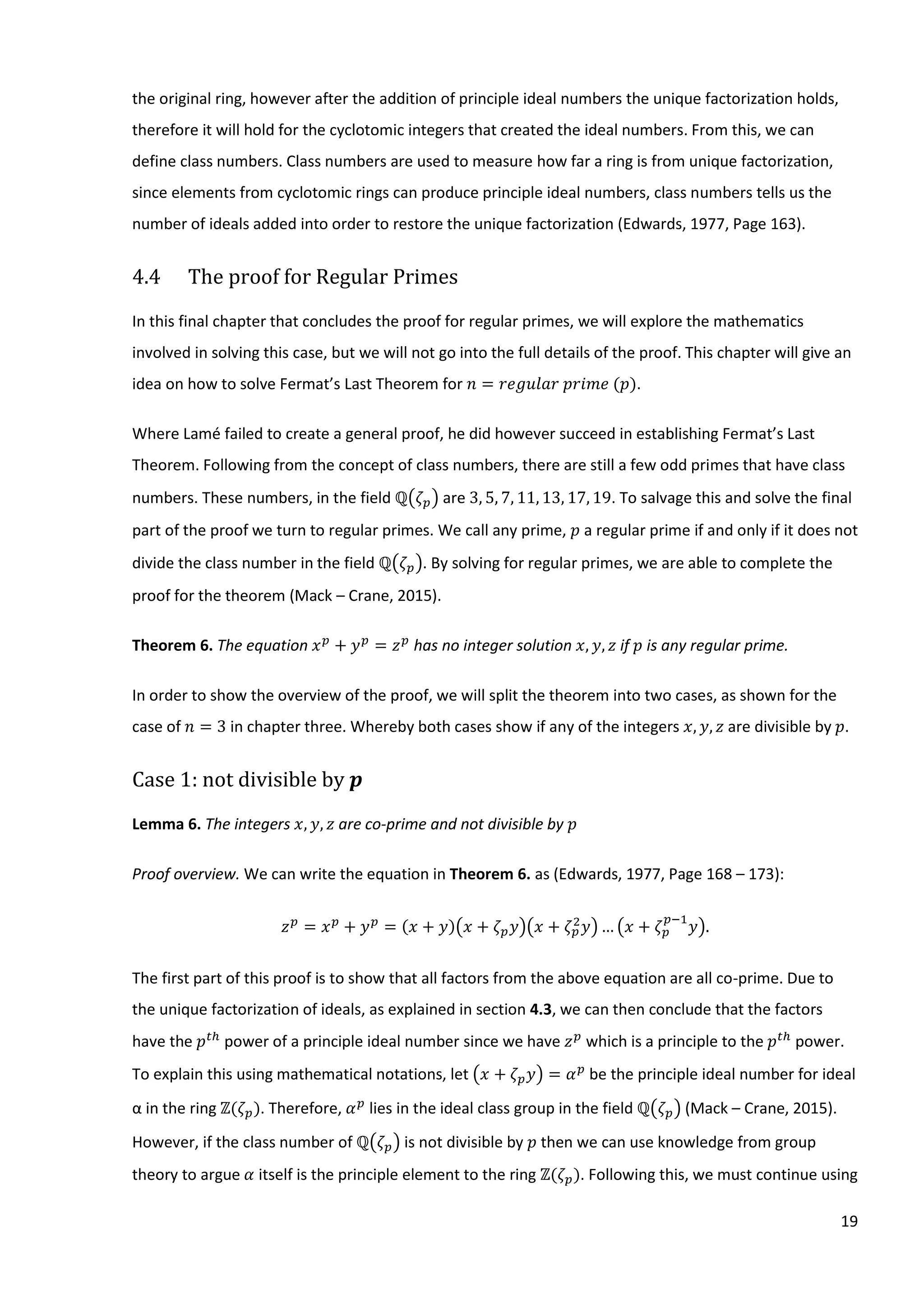
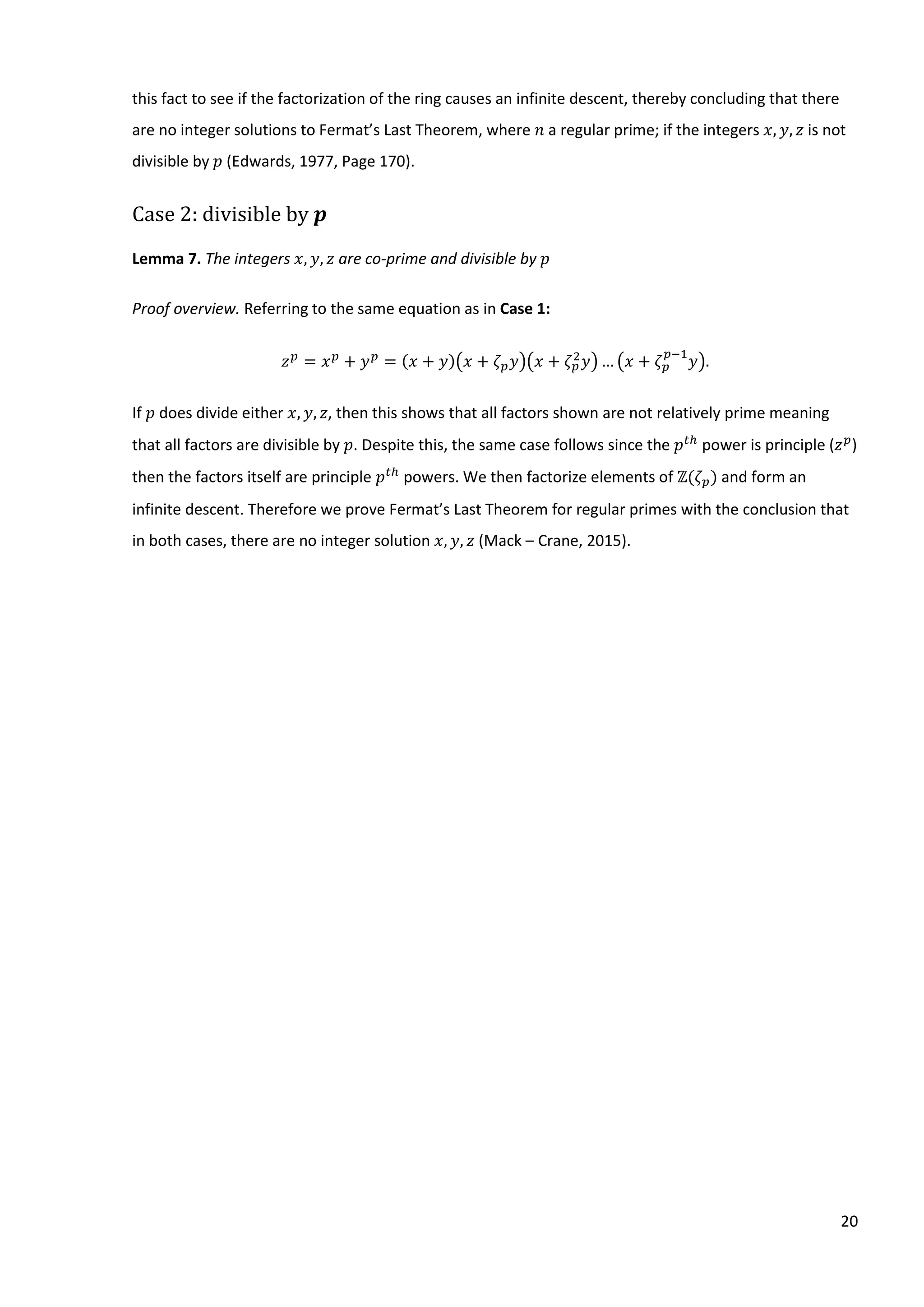
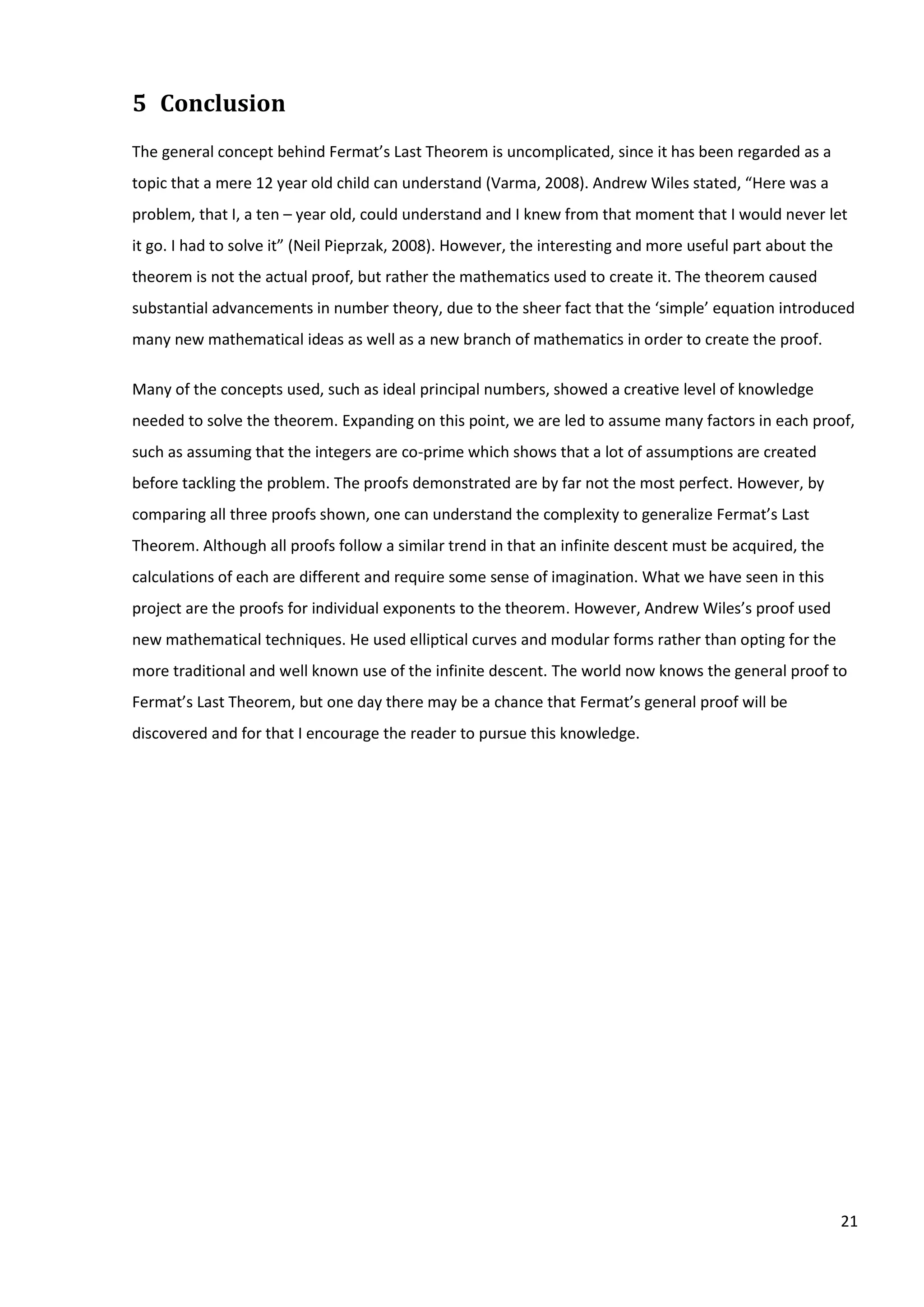
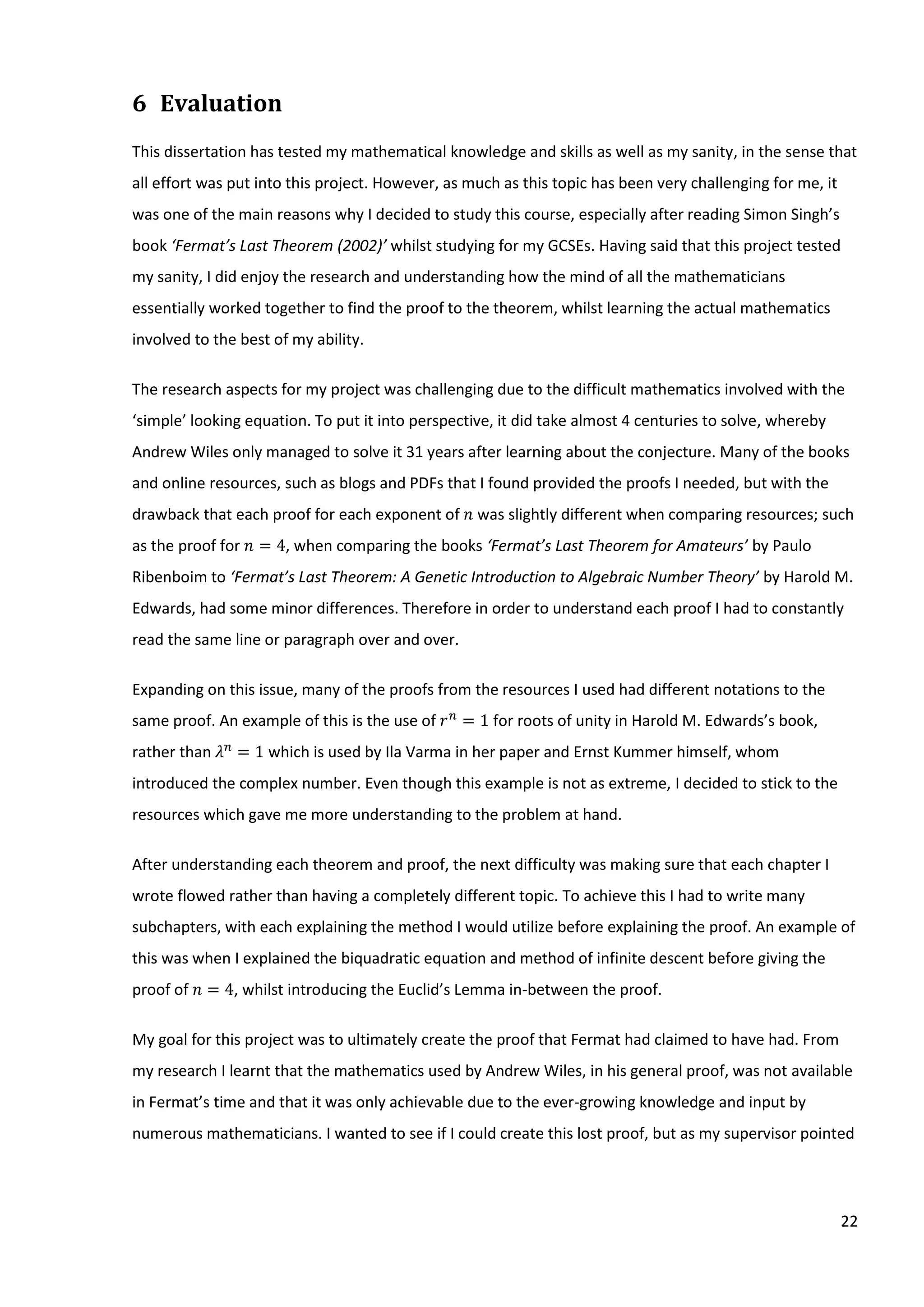
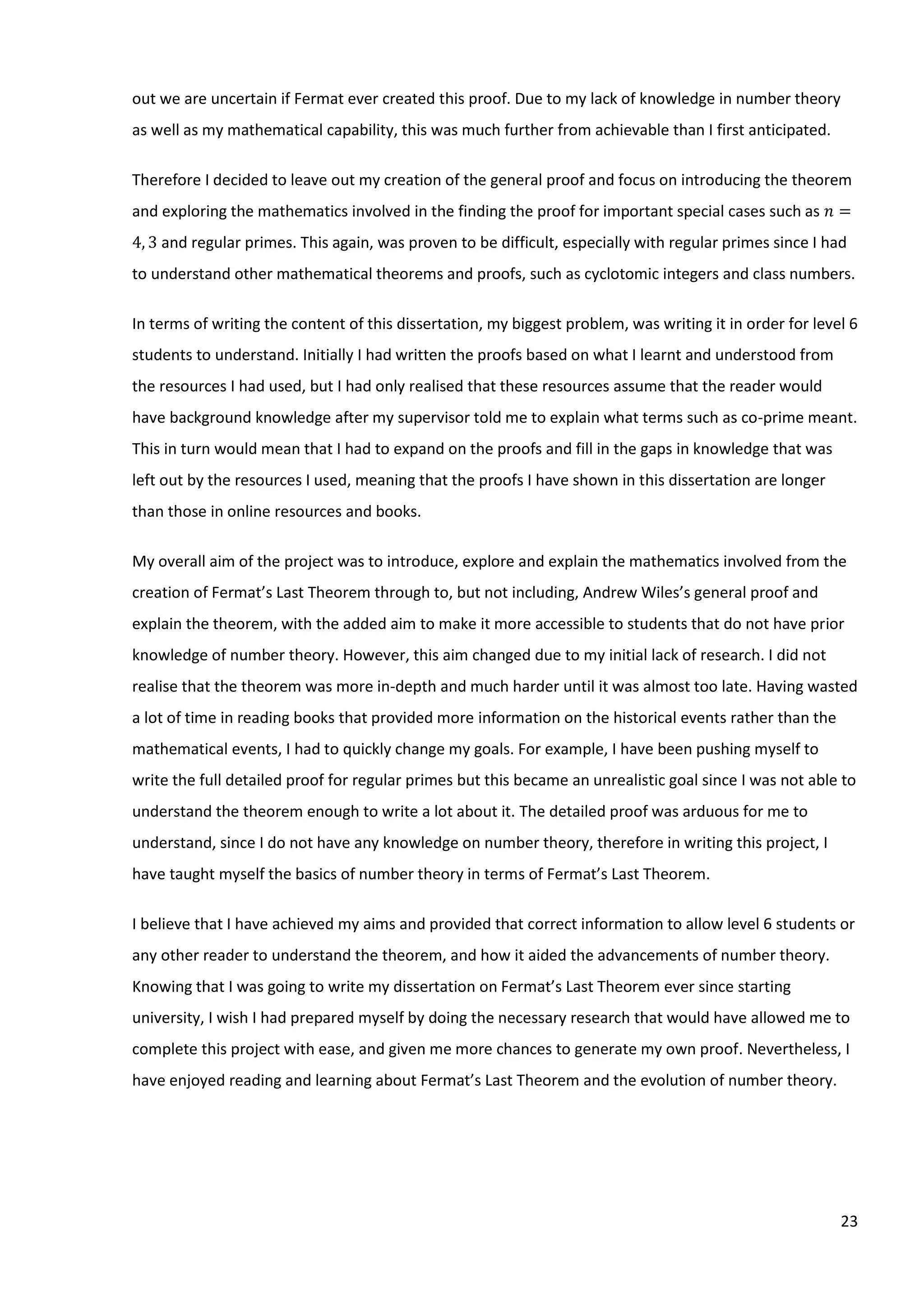
![24
7 Bibliography
Eberhart, C. (1999) Fermat and His Method of Infinite Descent [Online], Available:
<http://www.ms.uky.edu/~carl/ma330/html/bailey21.html> [Accessed 23rd November 2015]
Edwards, H. M. (1977) Fermat’s last theorem: A genetic introduction to algebraic number theory,
Germany: Springer-Verlag Berlin and Heidelberg GmbH & Co. K
Freeman, L. (2005) Fermat’s last theorem [Online], Available:
<http://fermatslasttheorem.blogspot.co.uk/> [Accessed 10th November 2015]
Mack-Crane, S. (2015) Fermat’s last theorem for regular primes, [Online] . Available:
<https://math.berkeley.edu/~sander/speaking/22September2015%20WIM%20Talk.pdf> [Accessed 4th
May 2016]
O’Connor, J. J. and Robertson, E. F. (1999) Euclid biography [Online], Available: <http://www-
groups.dcs.st-and.ac.uk/~history/Biographies/Euclid.html> [Accessed 3rd May 2016]
Pieprzak, N. (2008) Fermat’s last theorem and Andrew wiles [Online], Available:
<https://plus.maths.org/content/fermats-last-theorem-and-andrew-wiles> [Accessed 18th April 2016]
Ribenboim, P. (2013) Fermat’s last theorem for amateurs, United States: Springer-Verlag New York
Singh, S. (2002) Fermat’s last theorem: The story of a riddle that confounded the world's greatest minds
for 358 years, London: Fourth Estate
Singh, S. and Ribet, K. A. (1997) Fermat’s Last Stand, [Online] . Available:
<http://www.fis.cinvestav.mx/~lmontano/sciam/Fermat-SC1197-68.pdf> [Accessed 25th April 2016]
Varma, I. (2008) KUMMER, REGULAR PRIMES, AND FERMAT’S LAST THEOREM, [Online] . Available:
<http://www.math.harvard.edu/~ila/Kummer.pdf> [Accessed 4th April 2016]](https://image.slidesharecdn.com/85132124-5d34-4c0d-9c38-12262f7c352c-160714205513/75/Fermat-s-Last-Theorem-Final-Copy-29-2048.jpg)